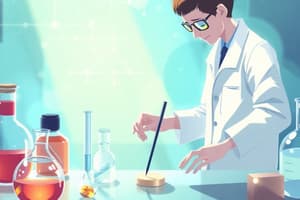Podcast
Questions and Answers
What is the difference between a hypothesis, theory, and law?
What is the difference between a hypothesis, theory, and law?
A hypothesis is a testable explanation for an observation, phenomenon, or scientific problem that can be tested through experimentation. A scientific theory, on the other hand, is a well-substantiated explanation of some aspect of the natural world that can incorporate facts, laws, inferences, and tested hypotheses. It is supported by a large body of evidence and has been repeatedly confirmed through experimentation and observation. A scientific law, however, is a statement based on repeated experimental observations that describes some aspect of the universe. It is a concise and universal description of a fundamental relationship in nature, often expressed mathematically.
List all the components that should be included in a graph.
List all the components that should be included in a graph.
A graph should include a title that describes the data being presented, labeled axes with units, data points plotted accurately, a key if multiple data sets are represented, and proper use of space so that the graph is easy to read and interpret.
What is the control group in this experiment?
What is the control group in this experiment?
The control group is the group of squirrels that received no compost.
What are the experimental groups in this experiment?
What are the experimental groups in this experiment?
Lactase is an enzyme that breaks down lactose. What type of macromolecule are lactase and lactose?
Lactase is an enzyme that breaks down lactose. What type of macromolecule are lactase and lactose?
Explain how enzymes catalyze reactions chemical reactions.
Explain how enzymes catalyze reactions chemical reactions.
What product is missing from the equation above?
What product is missing from the equation above?
Name the organelle the most associated with each of the following words and phrases:
A. Housing DNA:
B. Cellular respiration:
C. Photosynthesis:
D. Organization and packaging of cellular materials:
E. Digestion:
F. Protein synthesis:
Name the organelle the most associated with each of the following words and phrases: A. Housing DNA: B. Cellular respiration: C. Photosynthesis: D. Organization and packaging of cellular materials: E. Digestion: F. Protein synthesis:
Describe the pathway of a protein leaving the cell. In your explanation, make sure to include the names of the organelles it interacts with.
Describe the pathway of a protein leaving the cell. In your explanation, make sure to include the names of the organelles it interacts with.
Compare and contrast prokaryotic and eukaryotic cells.
Compare and contrast prokaryotic and eukaryotic cells.
How can you tell if a cell is a plant cell?
How can you tell if a cell is a plant cell?
Complete the chart by answering each question in the correct box.
Complete the chart by answering each question in the correct box.
In the drawing below, the red blood cells are in a saltwater solution. Label the following cells as isotonic, hypotonic, and hypertonic. Explain how you could tell from the picture.
In the drawing below, the red blood cells are in a saltwater solution. Label the following cells as isotonic, hypotonic, and hypertonic. Explain how you could tell from the picture.
Name three reasons why mitosis might occur.
Name three reasons why mitosis might occur.
Scientists like to use similar words to describe different concepts in a discipline. Define these terms students often use incorrectly: centriole, centromere, chromatin, chromosome, gene, cell division, binary fission.
Scientists like to use similar words to describe different concepts in a discipline. Define these terms students often use incorrectly: centriole, centromere, chromatin, chromosome, gene, cell division, binary fission.
What is the purpose of checkpoints in the cell cycle?
What is the purpose of checkpoints in the cell cycle?
Which phase do chromosomes move to the middle of the cell during?
Which phase do chromosomes move to the middle of the cell during?
When do the sister chromatids separate?
When do the sister chromatids separate?
During which phase do chromosomes first become visible?
During which phase do chromosomes first become visible?
Identify where cellular respiration and photosynthesis occur in the cell.
Identify where cellular respiration and photosynthesis occur in the cell.
Use the terms "anabolic" and "catabolic" to describe cellular respiration and photosynthesis are connected.
Use the terms "anabolic" and "catabolic" to describe cellular respiration and photosynthesis are connected.
Which part of cellular respiration is also found in fermentation? How many ATPs are produced by one glucose in fermentation? How does this compare to cellular respiration?
Which part of cellular respiration is also found in fermentation? How many ATPs are produced by one glucose in fermentation? How does this compare to cellular respiration?
Explain how ATP stores and releases energy.
Explain how ATP stores and releases energy.
Flashcards
Experiment
Experiment
Controlled experiment designed to test a specific hypothesis.
Hypothesis
Hypothesis
A proposed explanation for a phenomenon that can be tested.
Law
Law
A statement that describes a natural phenomenon that is consistently observed.
Theory
Theory
Signup and view all the flashcards
Independent Variable
Independent Variable
Signup and view all the flashcards
Dependent Variable
Dependent Variable
Signup and view all the flashcards
Control Variable
Control Variable
Signup and view all the flashcards
Control Group
Control Group
Signup and view all the flashcards
Experimental Group
Experimental Group
Signup and view all the flashcards
Inference
Inference
Signup and view all the flashcards
Substrate
Substrate
Signup and view all the flashcards
Enzyme
Enzyme
Signup and view all the flashcards
Active Site
Active Site
Signup and view all the flashcards
Nucleotide
Nucleotide
Signup and view all the flashcards
Carbohydrate
Carbohydrate
Signup and view all the flashcards
Monosaccharide
Monosaccharide
Signup and view all the flashcards
Polysaccharide
Polysaccharide
Signup and view all the flashcards
Lipid
Lipid
Signup and view all the flashcards
Protein
Protein
Signup and view all the flashcards
Amino Acid
Amino Acid
Signup and view all the flashcards
Nucleotide
Nucleotide
Signup and view all the flashcards
DNA
DNA
Signup and view all the flashcards
RNA
RNA
Signup and view all the flashcards
Cellular Respiration
Cellular Respiration
Signup and view all the flashcards
Photosynthesis
Photosynthesis
Signup and view all the flashcards
ATP
ATP
Signup and view all the flashcards
Autotroph
Autotroph
Signup and view all the flashcards
Heterotroph
Heterotroph
Signup and view all the flashcards
Prokaryotic Cell
Prokaryotic Cell
Signup and view all the flashcards
Eukaryotic Cell
Eukaryotic Cell
Signup and view all the flashcards
Nucleus
Nucleus
Signup and view all the flashcards
Organelle
Organelle
Signup and view all the flashcards
Mitosis
Mitosis
Signup and view all the flashcards
Cytokinesis
Cytokinesis
Signup and view all the flashcards
Chromosome
Chromosome
Signup and view all the flashcards
Study Notes
Exam Format
- Exam includes 2 open-response questions (must answer #1, can choose #2 or #3)
- 60 multiple-choice questions
Unit 1: Introduction to Biology - Vocabulary
- Scientific method
- Observation
- Hypothesis
- Prediction
- Evidence
- Experiment
- Dependent variable
- Independent variable
- Control variable
- Theory
- Law
- Control group
Unit 1: Introduction to Biology - Key Concepts/Skills
- Scientific Method
- Inferring using observations as evidence
- Constructing hypotheses
- Analyzing and interpreting data
- Experimental Design
- Identifying independent and dependent variables
- Designing and analyzing controlled experiments to test hypotheses
- Scientific Theories
- Differentiating between hypotheses, theories, and laws
- Graphing Skills
- Graphing and interpreting data (titles, labeled axes, keys if needed, proper use of space)
Unit 1: Practice Problems
- Problem 1: Distinguish between hypotheses, theories, and laws.
- Problem 2: A scientist studied squirrels' responses to winter temperatures.
- Independent variable: Temperature (e.g., 35 °C, 25 °C, 15 °C, 5 °C)
- Dependent variable: Squirrels' well-being (e.g., weight)
- Control: Consistent food, space, light, nests, etc.
Unit 2: Biochemistry - Vocabulary
- Polarity
- Polar molecule
- Polysaccharide
- Protein
- Hydrogen bond
- Amino acid
- Cohesion
- Enzyme
- Adhesion
- Lipid
- Chemical reaction
- Reactant
- Product
- Energy
- Activation energy
- Organic compound
- Fatty acids
- Catalyst
- Chemical bond
- Phospholipid
- Carbohydrate
- Nucleic acids
- Substrate
- Enzyme
- Monosaccharide
- RNA
- Glucose
- DNA
- Active site
Unit 2: Biochemistry - Key Concepts/Skills
- Properties of Water
- Drawing a water molecule
- Identifying properties of water
- Macromolecules
- Describing basic structure and function of carbohydrates, lipids, proteins, and nucleic acids
- Biochemical Reactions
- Identifying reactants and products in chemical reactions
- Explaining the conversation of matter in chemical reactions
- Explaining how energy is involved in a chemical reaction
- Enzymes
- Comparing and contrasting biochemical reactions with and without enzymes
- Explaining how enzymes work
- Designing and conducting experiments to test enzyme activity in different conditions (e.g., Lactase lab)
Unit 2: Practice Problems
- Problem 1: Identifying macromolecules associated with certain functions (e.g., storing energy, acting as enzymes, etc.)
- Problem 2: Identifying macromolecules associated with specific monomers (e.g., amino acids, nucleotides, fatty acids, and glycerol)
Unit 3: Cells/Cell Transport - Vocabulary
- Cells
- Prokaryotic cells
- Eukaryotic cells
- Organelle
- Nucleus
- Cell membrane
- Semipermeability/Selective Permeability
- Phospholipid bilayer
- Hydrophobic
- Hydrophilic
- Cytoplasm
- Cytoskeleton
- Ribosomes
- Mitochondria
- Endoplasmic reticulum
- Golgi apparatus
- Lysosomes
- Vacuoles
- Centrioles
- Chloroplasts
- Cell wall
- Diffusion
- Equilibrium
- Facilitated diffusion
- Transport protein
- Passive transport
- Active transport
- Osmosis
- Solute
- Solution
- Hypotonic
- Hypertonic
- Isotonic
- Endocytosis
- Exocytosis
Unit 3: Cells/Cell Transport - Key Concepts/Skills
- Cell Theory
- Explaining three components of cell theory
- Organelles Structure and Function
- Comparing and contrasting prokaryotic and eukaryotic cells
- Illustrating the structure/function of each organelle
- Demonstrating the role of the phospholipid bilayer in cell membrane function
- Cell Transport
- Differentiating between types of passive and active transport
- Determining the movement of molecules across the cell membrane based on concentration gradients
- Predicting the movement of water in hypotonic, isotonic, and hypertonic solutions
- Testing the effects of different salt concentrations on plant cells (e.g., osmosis lab)
Unit 3: Practice Problems
- Problem 1: Matching organelles with characteristics
- Problem 2: Describing the pathway of a protein leaving the cell (including interactions with organelles)
Unit 4: Cellular Energetics - Vocabulary
- ATP
- Light reactions
- Calvin cycle
- Photosynthesis
- Chloroplast
- Thylakoid
- Stroma
- Electron (energy) carriers
- Cellular respiration
- Aerobic
- Anaerobic
- Glycolysis
- Pyruvate
- Krebs cycle
- Electron transport chain
- ATP synthase
- Alcoholic fermentation
- Lactic acid fermentation
Unit 4: Cellular Energetics - Key Concepts/Skills
- Introduction to Metabolism/ATP
- Identifying differences between autotrophs and heterotrophs
- Comparing and contrasting photosynthesis and cellular respiration
- Explaining the role of glucose and ATP as energy-carrying molecules
- Photosynthesis
- Identifying the structure and functions of chloroplast parts used in photosynthesis
- Explaining how light energy is converted to chemical energy in photosynthesis
- Collecting/analyzing data to determine the effects of photosynthesis and cellular respiration on oxygen concentration
- Cellular Respiration
- Identifying the structure and functions of mitochondria parts used in cellular respiration
- Describing the stages of cellular respiration (glycolysis, Krebs cycle, electron transport chain)
- Explaining how energy from glucose is released to produce ATP through cellular respiration
- Fermentation
- Explaining how fermentation produces ATP via glycolysis only
Unit 4: Practice Problems
- Problem 1: Writing the chemical formula for photosynthesis (words and symbols)
- Problem 2: Writing the chemical formula for cellular respiration (words and symbols)
Unit 5: Cell Division - Vocabulary
- Cell division
- Prophase
- Parent cell
- Metaphase
- Daughter cell
- Anaphase
- Chromosome
- Telophase
- Synthesis (S)
- Gap 1 (G1)
- Gap 2 (G2)
- Chromatin
- Centrioles
- Spindle
- Checkpoints
- Centromere
- Cytokinesis
- Interphase
- Mitotic phase
- Homologous chromosomes
- Binary fission
Unit 5: Cell Division - Key Concepts/Skills
- Cell Cycle
- Comparing and contrasting cell division in prokaryotes and eukaryotes
- Listing events in the eukaryotic cell cycle phases
- Describing how the cell cycle is regulated by checkpoints
- Describing the structure and function of chromosomes
- Modeling each stage of mitosis (prophase, metaphase, anaphase, telophase)
- Differentiating cytokinesis in plant and animal cells
Unit 5: Practice Problems
- Problem 1: Reasons for mitosis
- Problem 2: Defining terms often misused by students (e.g., centriole, centromere, chromatin, chromosome, gene, cell division, binary fission)
- Problem 3: Purpose of checkpoints in the cell cycle
Studying That Suits You
Use AI to generate personalized quizzes and flashcards to suit your learning preferences.



